Bilateral Pulmonary Embolism
Clinical History: A 60-year-old female with pelvic fracture developed shortness of breath with tachycardia and tachypenea
Clinical History: A 60-year-old female with pelvic fracture developed shortness of breath with tachycardia and tachypenea. Spiral CT of chest done with contrast to R/O PE.
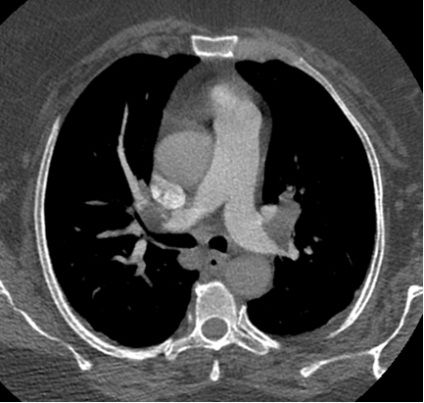

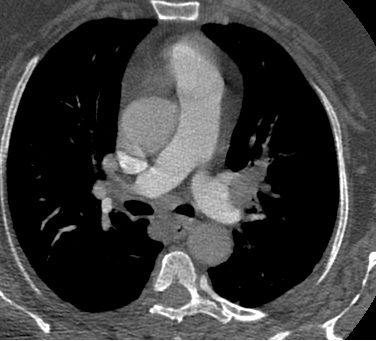
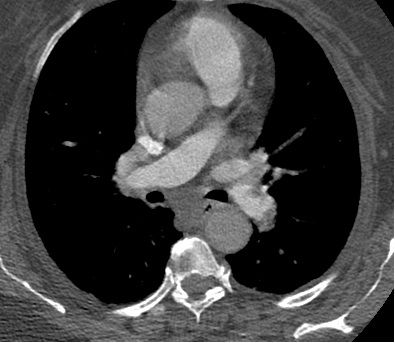
Lower lobe extension of thrombus.
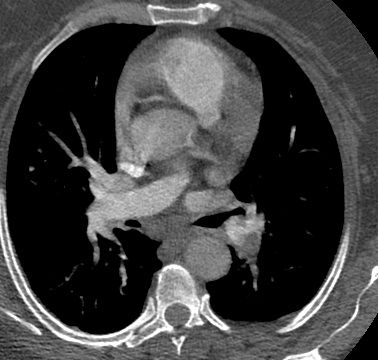

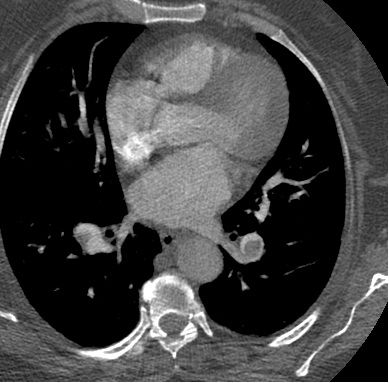
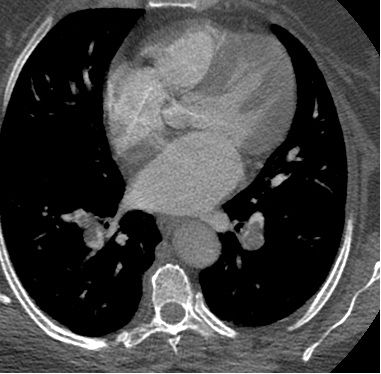

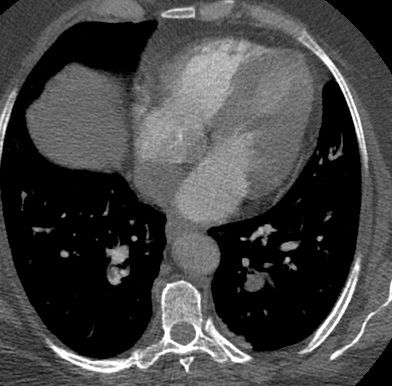
Diagnosis: Bilateral pulmonary embolism
Additional History: Patient had a fall and got a right acetabular fracture.
Discussion:
Pulmonary embolism is a common and potentially lethal condition. Most patients who succumb to pulmonary embolism do so within the first few hours of the event. Despite diagnostic advances, delays in pulmonary embolism diagnosis are common and represent an important issue. As a cause of sudden death, massive pulmonary embolism is second only to sudden cardiac death.
In patients who survive a pulmonary embolism, recurrent embolism and death can be prevented with prompt diagnosis and therapy. Unfortunately, the diagnosis is often missed because patients with pulmonary embolism present with nonspecific signs and symptoms. If left untreated, approximately one third of patients who survive an initial pulmonary embolism die from a subsequent embolic episode.
When a pulmonary embolism is identified, it is characterized as acute or chronic. In terms of pathologic diagnosis, an embolus is acute if it is situated centrally within the vascular lumen or if it occludes a vessel (vessel cutoff sign). Acute pulmonary embolism commonly causes distention of the involved vessel. An embolus is chronic if it is eccentric and contiguous with the vessel wall, it reduces the arterial diameter by more than 50 percent, evidence of recanalization within the thrombus is present, and an arterial web is present.
A pulmonary embolism is also characterized as central or peripheral, depending on the location or the arterial branch involved. Central vascular zones include the main pulmonary artery, the left and right main pulmonary arteries, the anterior trunk, the right and left interlobar arteries, the left upper lobe trunk, the right middle lobe artery, and the right and left lower lobe arteries. A pulmonary embolus is characterized as massive when it involves both pulmonary arteries or when it results in hemodynamic compromise. Peripheral vascular zones include the segmental and subsegmental arteries of the right upper lobe, the right middle lobe, the right lower lobe, the left upper lobe, the lingula, and the left lower lobe.
The variability of presentation sets the patient and clinician up for potentially missing the diagnosis. The challenge is that the "classic" presentation with abrupt onset of pleuritic chest pain, shortness of breath, and hypoxia is rarely seen. Studies of patients who died unexpectedly of pulmonary embolism revealed that the patients had complained of nagging symptoms, often for weeks, before dying. Forty percent of these patients had been seen by a physician in the weeks prior to their death.
Clinical signs and symptoms for pulmonary embolism are nonspecific; therefore, patients suspected of having pulmonary embolism-because of unexplained dyspnea, tachypnea, or chest pain or the presence of risk factors for pulmonary embolism-must undergo diagnostic tests until the diagnosis is ascertained or eliminated or an alternative diagnosis is confirmed. Further, routine laboratory findings are nonspecific and are not helpful in pulmonary embolism, although they may suggest another diagnosis. Pulmonary angiography remains the criterion standard for the diagnosis of pulmonary embolism, but with the improved sensitivity and specificity of CT angiography, it is now rarely performed.
Etiology:
Three primary influences predispose a patient to thrombus formation; these form the so-called Virchow triad, which consists of the following.
• Endothelial injury
• Stasis or turbulence of blood flow
• Blood hypercoagulability
Thrombosis usually originates as a platelet nidus on valves in the veins of the lower extremities. Further growth occurs by accretion of platelets and fibrin and progression to red fibrin thrombus, which may either break off and embolize or result in total occlusion of the vein. The endogenous thrombolytic system leads to partial dissolution; then, the thrombus becomes organized and is incorporated into the venous wall.
Pulmonary emboli usually arise from thrombi originating in the deep venous system of the lower extremities; however, they may rarely originate in the pelvic, renal, or upper extremity veins or the right heart chambers. After traveling to the lung, large thrombi can lodge at the bifurcation of the main pulmonary artery or the lobar branches and cause hemodynamic compromise. Smaller thrombi typically travel more distally, occluding smaller vessels in the lung periphery. These are more likely to produce pleuritic chest pain by initiating an inflammatory response adjacent to the parietal pleura. Most pulmonary emboli are multiple, and the lower lobes are involved more commonly than the upper lobes.
The causes for pulmonary embolism are multifactorial and are not readily apparent in many cases. The causes described in the literature include the following:
• Venous stasis
• Hypercoagulable states
• Immobilization
• Surgery and trauma
• Pregnancy
• Oral contraceptives and estrogen replacement
• Malignancy
• Hereditary factors
• Acute medical illness
A study by Malek et al confirmed the hypothesis that individuals with HIV infection are more likely to have clinically detected thromboembolic disease.[6] The risk of developing a pulmonary embolism or DVT is increased 40% in these individuals.
History:
The challenge in dealing with pulmonary embolism is that patients rarely display the classic presentation of this problem, that is, the abrupt onset of pleuritic chest pain, shortness of breath, and hypoxia. Studies of patients who died unexpectedly from pulmonary embolism have revealed that often these individuals complained of nagging symptoms for weeks before death. Forty percent of these patients had been seen by a physician in the weeks prior to their death.[2]
The following risk factors can be indications for the presence of pulmonary embolism:
• Venous stasis
• Hypercoagulable states
• Immobilization
• Surgery and trauma
• Pregnancy
• Oral contraceptives and estrogen replacement
• Malignancy
• Hereditary factors resulting in a hypercoagulable state
• Acute medical illness
• Drug abuse (intravenous [IV] drugs)
• Drug-induced lupus anticoagulant
• Hemolytic anemias
• Heparin-associated thrombocytopenia
• Homocystinemia
• Homocystinuria
• Hyperlipidemias
• Phenothiazines
• Thrombocytosis
• Varicose veins
• Venography
• Venous pacemakers
• Venous stasis
• Warfarin (first few days of therapy)
• Inflammatory bowel disease
The PIOPED II study listed the following indicators for pulmonary embolism:
• Travel of 4 hours or more in the past month
• Surgery within the last 3 months
• Malignancy, especially lung cancer
• Current or past history of thrombophlebitis
• Trauma to the lower extremities and pelvis during the past 3 months
• Smoking
• Central venous instrumentation within the past 3 months
• Stroke, paresis, or paralysis
• Prior pulmonary embolism
• Heart failure
• Chronic obstructive pulmonary disease
Diagnostic Considerations:
The variability of presentation for pulmonary embolism sets the patient and clinician up for potentially missing the diagnosis. Such missed diagnoses occur in approximately 400,000 patients in the United States per year; approximately 100,000 deaths could be prevented with proper diagnosis and treatment.
The diagnostic challenge is that the "classic" presentation of the condition, with abrupt onset of pleuritic chest pain, shortness of breath, and hypoxia, is rarely seen. Studies of patients who died unexpectedly from pulmonary embolism have revealed that the patients complained of nagging symptoms, often for weeks, before dying. Forty percent of these patients had been seen by a physician in the weeks prior to their death.
The differential diagnoses are extensive, and they should be considered carefully with any patient thought to have pulmonary embolism. These patients also should have an alternative diagnosis confirmed, or pulmonary embolism should be excluded, before discontinuing the workup. Additional problems to be considered include the following:
• Musculoskeletal pain
• Pleuritis
• Pericarditis
• Salicylate intoxication
• Hyperventilation
• Silicone pulmonary embolism
• Lung trauma
• Mediastinitis, acute
Sushila Ladumor, MD, FRCR, Consultant Radiologist with Multi-modality Imaging experience, working in Medical Imaging Department, King Abdulaziz Medical City, Riyadh, Saudi Arabia.
References
1. Ozsu S, Oztuna F, Bulbul Y, et al. The role of risk factors in delayed diagnosis of pulmonary embolism. Am J Emerg Med. Jan 2011;29(1):26-32. [Medline].
2. Kline JA, Runyon MS. Pulmonary embolism and deep venous thrombosis. In: Marx JA, Hockenberger RS, Walls RM, eds. Rosen's Emergency Medicine Concepts and Clinical Practice. Vol 2. 6th ed. 1368-1382..
3. Boyden EA. Segmental Anatomy of the Lungs: Study of the Patterns of the Segmental Bronchi and Related Pulmonary Vessels. New York, NY: McGraw-Hill; 1955:23-32.
4. Mitchell RN, Kumar V. Hemodynamic disorders, thrombosis, and shock. In: Kumar V, Cotran RS, Robbins SL, eds. Basic Pathology. 6th ed. Philadelphia, Pa: WB Saunders; 1997:60-80.
5. Wharton LR, Pierson JW. JAMA. Minor forms of pulmonary embolism after abdominal operations.
6. Malek J, Rogers R, Kufera J, Hirshon JM. Venous thromboembolic disease in the HIV-infected patient. Am J Emerg Med. Mar 2011;29(3):278-82. [Medline].
7. Geerts WH, Code KI, Jay RM, Chen E, Szalai JP. A prospective study of venous thromboembolism after major trauma. N Engl J Med. Dec 15 1994;331(24):1601-6. [Medline].
8. van den Heuvel-Eibrink MM, Lankhorst B, Egeler RM, Corel LJ, Kollen WJ. Sudden death due to pulmonary embolism as presenting symptom of renal tumors. Pediatr Blood Cancer. May 2008;50(5):1062-4. [Medline].
9. http://emedicine.medscape.com/article/300901
Clarius Mobile Health Unveils Anterior Knee Feature for Handheld Ultrasound
April 23rd 2025The T-Mode Anterior Knee feature reportedly offers a combination of automated segmentation and real-time conversion of grayscale ultrasound images into color-coded visuals that bolster understanding for novice ultrasound users.
The Reading Room Podcast: Current Perspectives on the Updated Appropriate Use Criteria for Brain PET
March 18th 2025In a new podcast, Satoshi Minoshima, M.D., Ph.D., and James Williams, Ph.D., share their insights on the recently updated appropriate use criteria for amyloid PET and tau PET in patients with mild cognitive impairment.
What is the Best Use of AI in CT Lung Cancer Screening?
April 18th 2025In comparison to radiologist assessment, the use of AI to pre-screen patients with low-dose CT lung cancer screening provided a 12 percent reduction in mean interpretation time with a slight increase in specificity and a slight decrease in the recall rate, according to new research.